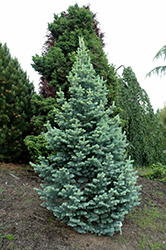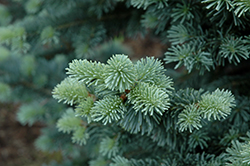It's all about ...
plants

Compact Alpine Fir
Abies lasiocarpa 'Compacta'
Height: 8 feet
Spread: 5 feet
Sunlight:
![]()
![]()
Hardiness Zone: 3b
Other Names: Subalpine Fir, Rocky Mountain Fir
Description:
A compact version of this Rocky Mountain native, ideal for bringing a splash of blue-green color to the garden, not to mention it's narrow pyramidal shape; tolerates drier conditions than most firs
Ornamental Features
The Compact Alpine Fir is a dwarf conifer which is primarily valued in the landscape or garden for its distinctively pyramidal habit of growth. It has bluish-green evergreen foliage. The needles remain bluish-green throughout the winter.
Landscape Attributes
The Compact Alpine Fir is a dense multi-stemmed evergreen shrub with a distinctive and refined pyramidal form. Its relatively fine texture sets it apart from other landscape plants with less refined foliage.
This is a relatively low maintenance shrub, and usually looks its best without pruning, although it will tolerate pruning. It has no significant negative characteristics.
The Compact Alpine Fir is recommended for the following landscape applications;
- Accent
- General Garden Use
Planting & Growing
The Compact Alpine Fir will grow to be about 8 feet tall at maturity, with a spread of 5 feet. It tends to fill out right to the ground and therefore doesn't necessarily require facer plants in front, and is suitable for planting under power lines. It grows at a slow rate, and under ideal conditions can be expected to live for 70 years or more.
This shrub does best in full sun to partial shade. It prefers to grow in average to moist conditions, and shouldn't be allowed to dry out. It is not particular as to soil pH, but grows best in sandy soils. It is quite intolerant of urban pollution, therefore inner city or urban streetside plantings are best avoided. This is a selection of a native North American species.
This plant is not reliably hardy in our region, and certain restrictions may apply; contact the store for more information.

